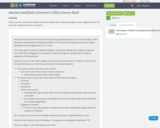
Please use this course shell in tandem with the PanOpen text, as they are designed to work together and for the text to be integrated into the courseshell.
- Subject:
- Literature
- Material Type:
- Full Course
- Author:
- Robert Ladd
- Date Added:
- 07/30/2021

Please use this course shell in tandem with the PanOpen text, as they are designed to work together and for the text to be integrated into the courseshell.

This lesson addresses the common student misconception that the Earth is closer to the Sun during the summer in the Northern Hemisphere. This lesson encourages students to voice this misconception at the beginning of the lesson and then attempts to correct it-first, by exploring the reason for it, and then by presenting an alternate explanation. Materials needed for the demonstration include a small globe and a desk lamp for each group of students, a large ball, and overhead transparency. This resource is from PUMAS - Practical Uses of Math and Science - a collection of brief examples created by scientists and engineers showing how math and science topics taught in K-12 classes have real world applications.

Please use this course shell as a frame to adapt current courses into a Universal Design for Learning Format or as a frame to build and new courses.

Students learn about the causes, composition and types of volcanoes. They begin with an overview of the Earth's interior and how volcanoes form. Once students know about how a volcano functions, they learn how engineers predict eruptions. In a class demonstration, students watch and measure a mock volcanic eruption and observe the phases of an eruption, seeing how a volcano gets its shape and provides us with clues to predict a blast.

This activity, effective outdoors or indoors, demonstrates how insolation is affected by latitude by using a pair of thermometers, each taped to some cardboard, placed outside on a sunny day. A globe can also be used, outdoors or indoors. Students learn that seasonal variations in temperature are the result of the heating of the Sun as a function of its peak angle and length of the day. A template for a folded paper structure to explore the effects of the angle of illumination on heating is included. The resource is from PUMAS - Practical Uses of Math and Science - a collection of brief examples created by scientists and engineers showing how math and science topics taught in K-12 classes have real world applications.